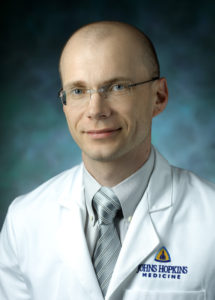 Dr. Pustavoitau graduated with honors from the Belarussian State Medical University in 2000. His specialty training included residency in anesthesiology at Wayne State University/ Detroit Medical Center (completed in 2006), and fellowship in critical care medicine at the Johns Hopkins University (completed in 2007). He also received an advanced degree (MHS) in clinical investigation through the Johns Hopkins Bloomberg School of Public Health/ Johns Hopkins School of Medicine in 2013. Dr. Pustavoitau achieved a testamur status in perioperative transesophageal echocardiography through the American Board of Echocardiography in 2006.
Dr. Pustavoitau graduated with honors from the Belarussian State Medical University in 2000. His specialty training included residency in anesthesiology at Wayne State University/ Detroit Medical Center (completed in 2006), and fellowship in critical care medicine at the Johns Hopkins University (completed in 2007). He also received an advanced degree (MHS) in clinical investigation through the Johns Hopkins Bloomberg School of Public Health/ Johns Hopkins School of Medicine in 2013. Dr. Pustavoitau achieved a testamur status in perioperative transesophageal echocardiography through the American Board of Echocardiography in 2006.
Dr. Pustavoitau is currently an Associate Professor in the Department of Anesthesiology and Critical Care Medicine in the Johns Hopkins School of Medicine. Throughout his practice, he attends to patients in both the operating room and intensive care units.
Dr. Pustavoitau acquired broad research experiences including evaluating anesthetic mechanisms using Magnetic Resonance Spectroscopy, investigating clinical utility of biomarker of aging p16INK4a mRNA expression in peripheral blood T-lymphocytes, clinical outcomes research and computational modeling and simulation of hemostasis. His current research and clinical focus is on improving care and outcomes of patients undergoing liver transplantation. As part of a multidisciplinary effort, he has worked with a team to develope the database, several active IRB-approved protocols, consistent intraoperative anesthesia-related data collection, as well as presented work at national and international conferences. Dr. Pustavoitau also had the honor to serve as a co-director of the ILTS Perioperative Care in Liver Transplantation Conference, Washington, DC in 2012, and is a co-editor of a review issue of International Anesthesiology Clinics on liver transplantation scheduled for publication in late 2016.
In parallel to research and clinical activities, Dr. Pustavoitau has dedicated substantial effort to introducing critical care ultrasound into critical care practice at the institutional and national levels. The result of this work is participation in multiple educational activities, organization of workshops, publication of statements by the Society of Critical Care Medicine and the Society of Critical Care Anesthesiologists, and co-editing of a book on comprehensive critical care ultrasound.